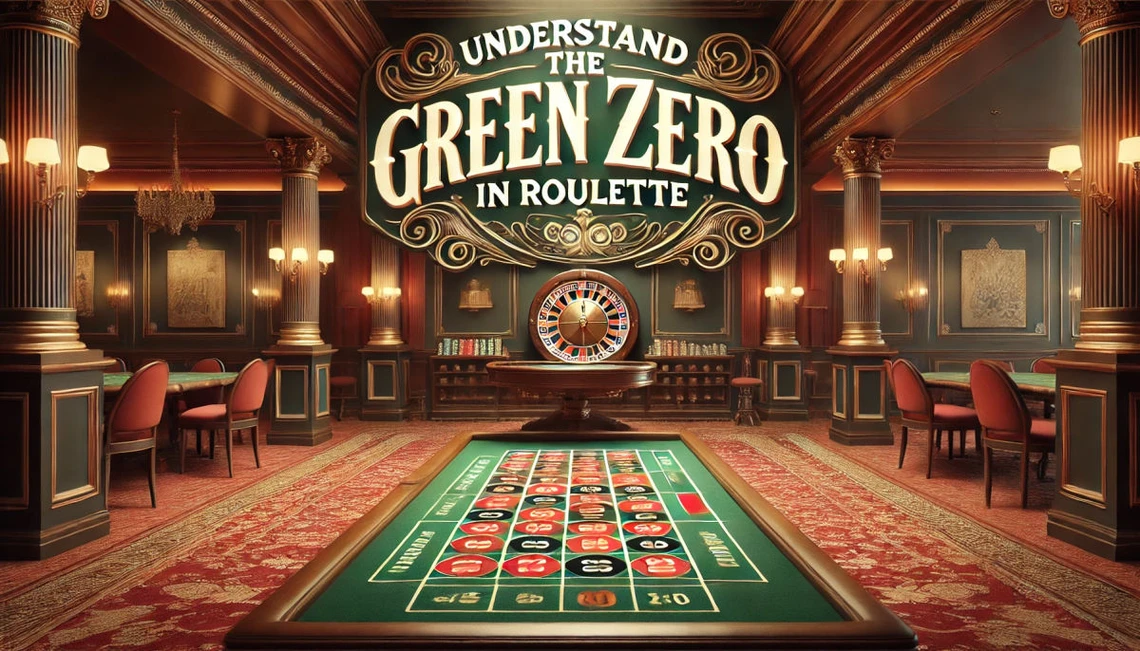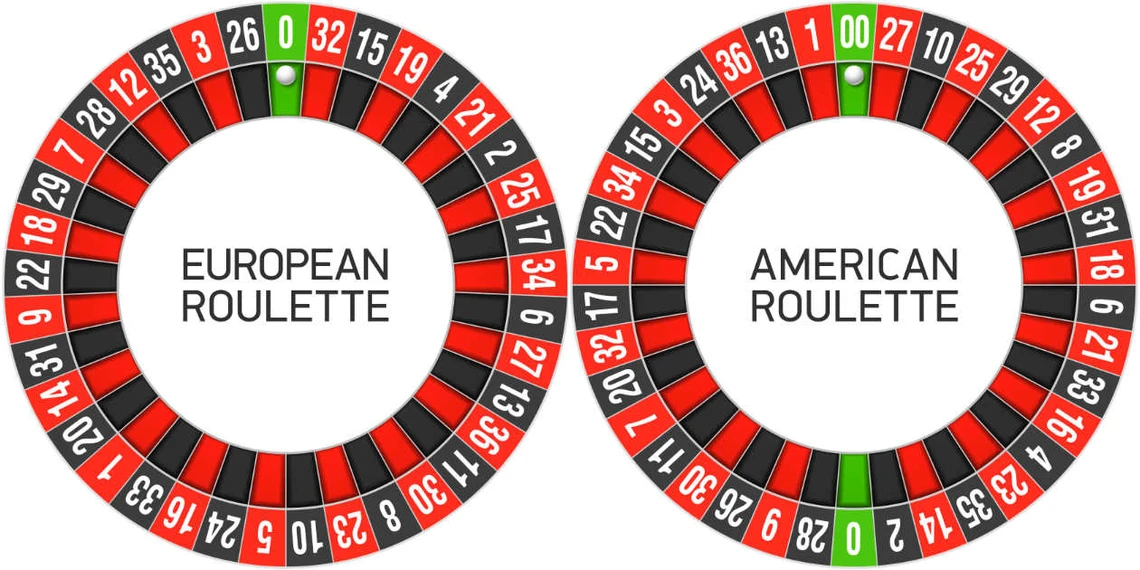
Understand the Green 0 (zero) in Roulette

The green zero on a roulette wheel may seem minor, but it plays a key role in shaping the game’s odds and betting options.
This distinct pocket isn't just an aesthetic choice; it's a defining feature that shapes the very nature of the game. Whether you're playing European roulette with its single zero or the American version that adds a double zero into the mix, understanding the role of the green zero is key to grasping how roulette really works.
In this article, we'll explore the significance of the green zero, debunk common myths surrounding it, and reveal how it impacts your odds and strategies at the roulette table.
Meaning of the Green Zero in Roulette
In roulette, the color green is uniquely associated with the zero (and double zero in American roulette). While the numbers 1 through 36 are evenly split between red and black, the zero stands apart in green. This color designation highlights the zero's special status in the game. Unlike the other numbers, the green zero does not belong to any of the standard betting categories such as red or black, odd or even, or high or low. This distinction affects betting options and outcomes, making the zero a pivotal element in roulette's design.
The Green Zero in Different Roulette Variants
Roulette comes in several variants, with the primary difference being the presence and number of green zeros on the wheel.
- European Roulette: Features a single green zero (0) on the wheel, resulting in 37 slots numbered from 0 to 36. This version offers better odds for players due to the single zero, which reduces the house edge.
- American Roulette: Includes both a green zero (0) and a green double zero (00), bringing the total to 38 slots. The addition of the double zero increases the house edge, making it less favorable for players compared to the European version.
Other versions, like French roulette, also have a single zero but may include special rules affecting bets involving zero. The presence of zeros is a fundamental aspect that distinguishes roulette variants and influences gameplay strategies.
Misconceptions About the Zero
Several myths surround the green zero in roulette:
- Myth: Betting on zero has a higher chance of winning because it's unique.
Clarification: The probability of the ball landing on zero is the same as any other single number. Its uniqueness lies in its impact on the house edge and certain bets, not in increased likelihood.
- Myth: The zero is due to come up after not appearing for many spins.
Clarification: Roulette spins are independent events governed by random chance. Previous outcomes do not influence future results—a misconception known as the Gambler's Fallacy.
Appearance and Placement of Zero on the Roulette Wheel
Color and Numbering of Zero
The zero is distinctively marked in green on the roulette wheel, setting it apart from the red and black numbered slots. In European roulette, there is one green zero (0). In American roulette, there are two green zeros: the zero (0) and the double zero (00). This consistent use of green universally signals the zero's special function in the game.
The green of zero serves three key purposes:
- Practical distinction: It visually differentiates from red and black, preventing confusion during the game.
- Symbolic neutrality: It represents zero's unique status, as it doesn't belong to standard betting groups like red/black or even/odd.
- Marker of authority: The green box highlights the house edge, reinforcing zero's special significance in the game.
Visual Differences Between Roulette Wheels
The design of the roulette wheel varies between the European and American versions, primarily due to the number of zeros.

European Roulette Wheel:
- Contains 37 pockets numbered from 0 to 36.
- Features a single green zero.
- The numbers are arranged in a specific sequence to balance high and low, odd and even numbers.
American Roulette Wheel:
- Contains 38 pockets numbered from 0 to 36, plus a double zero (00).
- Features both a green zero and a green double zero.
- The number sequence differs from the European wheel to accommodate the extra zero.
These visual differences affect the game's odds and are significant in gameplay. The additional zero on the American wheel increases the house edge, influencing players' strategies and potential returns.
Betting on Green Zero in Roulette
Can You Bet on Green in Roulette?
Yes, players can bet directly on the green zero:
- Explanation of Betting Options for Zero: Straight-Up Bet: Place chips directly on the zero (0) or double zero (00) on the betting layout.
- How to Place a Bet on Zero at the Table: Locate the zero(s) on the betting layout and place your chips on the desired betting spot before the dealer closes betting.
Betting Options Involving Zero
There are bets and specials that include zero:
Bets Involving the Zero:
- Split Bets: Zero with 1, 2, or 3.
- Street Bets: Bets covering zero and two adjacent numbers.
- Corner Bets: Involves zero and three other numbers in a square layout.
Special Bets: Neighbor Bets and Zero Spiel:
- Neighbor Bets: Betting on a number and its immediate neighbors on the wheel.
- Zero Spiel (Zero Game): A bet common in European casinos covering zero and specific surrounding numbers.
These bets allow players to increase their coverage of the wheel and potentially improve their chances of winning when the ball lands near zero.
Should You Bet on Green Zero?
Betting on zero has its pros and cons:
High payout potential with 35 to 1 odds.
Adds excitement and diversity to betting strategies.
Lower probability of winning compared to even-money bets.
Higher house edge impacts expected returns over time.
To learn more about this you can read our article about : When To Bet On Zero in Roulette?
Odds and Probabilities Related to Green Zero
Odds of Hitting Green Zero
The statistical probability of the ball landing on a green zero depends on the roulette variant:
European Roulette:
- Total of 37 pockets.
- Probability of hitting zero: 1 in 37 (approximately 2.70%).
American Roulette:
- Total of 38 pockets.
- Probability of hitting zero: 1 in 38 (approximately 2.63%).
- Probability of hitting double zero: 1 in 38 (approximately 2.63%).
- Combined probability of hitting any zero (0 or 00): 2 in 38 (approximately 5.26%).
|
Roulette Variant
|
Total Pockets
|
Outcome
|
Probability
|
|---|---|---|---|
|
European Roulette |
37
|
Hitting Zero
|
1 in 37 (2.70%)
|
|
American Roulette |
38
|
Hitting Zero
|
1 in 38 (2.63%)
|
|
American Roulette |
38
|
Hitting Double Zero
|
1 in 38 (2.63%)
|
|
American Roulette |
38
|
Hitting Any Zero (0 or 00)
|
2 in 38 (5.26%)
|
Calculating these odds helps players understand the risk associated with betting on zero and informs their overall betting strategy.
House Edge Introduced by Zeros
The presence of zeros increases the casino's advantage:
- European Roulette House Edge: Approximately 2.70% due to the single zero.
- American Roulette House Edge: Approximately 5.26% because of the additional double zero.
The zeros affect all bets, especially even-money bets like red/black or odd/even, since zero is neither red nor black, odd nor even. This means there's a higher chance of losing these bets when the ball lands on zero(s), impacting long-term gameplay and potential winnings.
How Much Does Green Pay in Roulette?
European Roulette:
- Straight-Up Bet on Zero (0):
- Payout: 35 to 1.
- Example: A successful $1 bet on zero returns $35 in winnings, plus the original $1 stake.
- Comparison with Other Bets: Straight-up bets on any single number also pay 35 to 1. Even-money bets, such as red/black or odd/even, pay 1 to 1 but have a higher probability of winning.
- Unique Considerations: Betting on zero carries the same payout as other single-number bets but comes with its unique impact on the house edge, as the zero tilts the odds in the casino's favor.
American Roulette:
- Straight-Up Bet on Zero (0) or Double Zero (00):
- Payout: 35 to 1 for both zero (0) and double zero (00).
- Example: A successful $1 bet on either zero or double zero returns $35 in winnings, plus the original $1 stake.
- Impact on Potential Winnings:
- While the payout remains the same (35 to 1), the house edge is higher in American roulette because of the additional double zero. This increases the overall advantage for the casino, reducing the player's long-term expected winnings compared to European roulette.
- The presence of the double zero adds an extra layer of risk, making American roulette less favorable for players than European roulette.
|
Roulette Variant
|
Bet Type |
Payout
|
|---|---|---|
|
European Roulette |
Straight-Up Bet on Zero (0)
|
35 to 1
|
|
American Roulette |
Straight-Up Bet on Zero (0) or Double Zero (00)
|
35 to 1 for both zero (0) and double zero (00)
|
Players should be aware of these differences when choosing between roulette variants and deciding on their betting strategies.
Recap of the Green Zero's Significance:
The green zero is a fundamental element of roulette that influences the game's odds, payouts, and strategies. Its presence affects the house edge and alters the dynamics of betting options.
Summary of Key Points Discussed:
- The zero's green color distinguishes it from other numbers, indicating its special role.
- European and American roulette differ primarily in the number of zeros, affecting odds and house edge.
- Misconceptions about the zero can lead to flawed betting strategies.
- Betting on zero offers high payouts but comes with lower odds of winning.
- Incorporating zero into betting strategies requires careful risk assessment.
Final Advice:
The green zero in roulette plays a crucial role in affecting the house edge, and understanding its impact is essential for informed betting. While betting on zero can be exciting, players must balance risks and rewards. Responsible gambling requires knowledge of the game, awareness of odds, and good bankroll management.

Author
Content Writer